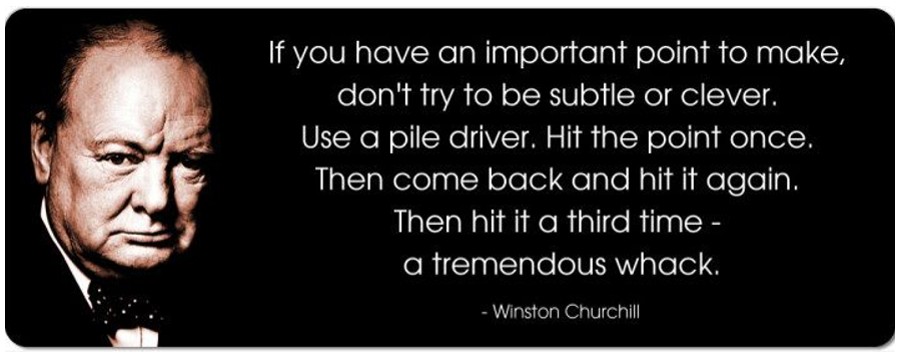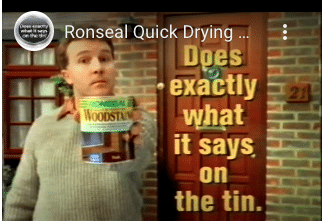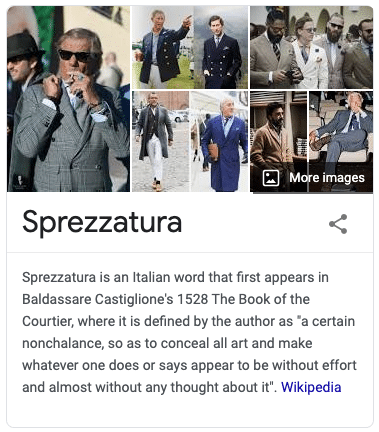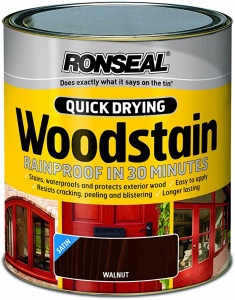
All local advertising can be boiled down to two slogans — or so I’ve claimed before.
And one of those two slogans comes from Ronseal:
“It does exactly what it says on the tin.”
 Well, below is the original ad that spawned that slogan, and it’s a work of genius.
Well, below is the original ad that spawned that slogan, and it’s a work of genius.
But be warned: It won’t look or sound like a fancy-schmancy, award-winning “creative” ad.
You’re not liable to be impressed with it on first viewing.
But back in 1994 this ad leapfrogged Ronseal from an also-ran to become the sales and market-share leader in its category and did so on a comparatively tiny media budget.
Better yet, this deceptively simple ad also managed to lodge its slogan deep into the cultural collective consciousness of the UK.
The slogan even made it into the Oxford Dictionary of Idioms and was repeatedly used by then-Prime Minister David Cameron.
What more could you want from a 30-second TV spot?
Check it out:
Don’t Think “Artless”; Think “Sprezzatura”
Don’t be deceived by the apparently artless, “just tell it like it is” nature of the ad.
In this case, form follows function.
 Liz Whiston and Dave Shelton of ad agency HHCL very specifically chose to have the form of the ad mimic the persuasive intent.
Liz Whiston and Dave Shelton of ad agency HHCL very specifically chose to have the form of the ad mimic the persuasive intent.
They wanted to de-mystify the product and to create an anti-ad-speak spot.
So instead of delving into the formulation of the wood stain or showing comparisons of how much more protective or quicker-drying it was than the competition — all of which would have sounded like advertising puffery — they opted for a straight-talking approach.
Just understand that as much as the copy may seem off the cuff, that particular style and wording was actually very intentional and studied.
It may not seem impressive at first glance, but a closer look reveals its almost poetic construction.
Rather than demonstrating the product, the ad copy itself embodies and demonstrates the “what you see is what you get” philosophy.
Just check out the script:
“This is Ronseal Quick-Drying Woodstain. You can’t miss it – it comes in a tin with Ronseal Quick-Drying Woodstain on it.
[Right off the bat they demonstrate that what you see in the store is what you’ll get when you buy it. They also take pains to show you the packaging so you can identify it at the store]
It protects, and it’s rain-proof in about 30 minutes. Which means in about 30 minutes your wood’s rainproof and protected.
[Another enactment of “It does what it claims” in a form that’s inarguable even when presented to a jaded public.]
So, if you’ve got wood to stain and you want it to dry quickly… use Ronseal Quick-Drying Woodstain.
[Classic Call to Action that again repeats the notion that the product actually does what its name promises]
It does exactly what it says on the tin.’
[The final, legendary closing line and slogan which sums up the previous three demonstrations and claims that the product does what it claims]
The first thing that likely jumps out at you when you read this is the almost extreme amount of repetition in the ad.
And the artistry is revealed in the fact that you don’t chafe at that repetition when you watch and hear the ad.
It doesn’t feel nearly as repetitive as it is. If anything, it seems more like a straightforward “see it and say it” format.
This is your big clue that the repetition isn’t a flaw, it’s a feature.
The ad perfectly follows Churchill’s advice on the matter:
“If you have an important point to make, don’t try to be subtle or clever. Use a pile driver. Hit the point once. Then come back and hit it again. Then hit it a third time — a tremendous whack.”
Accordingly, the opening phrase of the ad demonstrates that the tin does, in fact, plainly state exactly what it does in a “can’t miss it” fashion.
The ad even does a close-up on the tin, so you can see for yourself how well labeled it is.
Not only is this a clever proof point, but it’s also a crucial visual to include in the ad to ensure customers will recognize the product on store shelves.
Then in the body of the copy, the ad hits this same essential point two and three times, even while covering the product’s essential benefits.
Exactly how quick is “quick-drying”? Only 30 minutes till your wood is rainproof and protected.
“So if you’ve got wood to stain and you want it to dry quickly… use Ronseal Quick-Drying Woodstain.”
This ad was made well before the age of Google PPC advertising, but it embodies a central truth of writing PPC Ads:
Always put the searched-for keywords front and center, then repeat them as much as reasonably possible.
This ad uses “Quick Drying Wood Stain” about as much as humanly possible in a 30-second ad, doesn’t it?
Then there’s the third “hit” in the Call-to-Action before the final, legendary last line provides the “tremendous whack”:
“Does Exactly What It Says On The Tin.”
Not only does this ad embody Churchill’s advice, but it’s also the perfect expression of Ogilvy’s “Positively Good” advertising philosophy:
A product’s ad doesn’t have to claim to it be the best; it’s often enough for the ad to honestly claim the product to be “positively good,” aka “the sure thing.”
Applying Ronseal’s Brilliance to Your Advertising
There are three clear lessons to take from this:
1. The Power of Being “The Honest Goods”
Better to take a “Positively Good” approach to your ads than to create some kind of faux, trumped-up Unique Selling Proposition or engage in ad-speak puffery about your product or service.
2. Clarity Beats “Creativity”
Unless your ad’s creativity is being used to sharpen the point, or to communicate the point on a more emotional level, then it’s misdirected creativity at best, and a complete waste of your ad budget at worst.
If you can’t easily explain how the creativity and execution in your ads ties back to an overall strategy to increase sales… well, then there’s a good chance you need a new ad campaign.
3. Repetition is King
Anybody competent in the branding game knows that frequency is all important — people need to hear or see your ad enough times per week over enough weeks and years to get the message to “sink in.”
 But repetition isn’t limited to advertising schedules and exposures per ad. Repetition of the central point within each ad is almost always needed.
But repetition isn’t limited to advertising schedules and exposures per ad. Repetition of the central point within each ad is almost always needed.
You don’t necessarily need to make the same point the same way in the exact same words to do this.
But you definitely want your ads to make the same points in different ways, with maybe slightly variations of words, over and over again.
And this is true both within an individual ad AND from one ad to another AS WELL AS from one customer touchpoint to another.
Just as Ronseal ensures the messaging ON their “tin” reflects the advertisements’ messaging about their product, so you’ll want to ensure that your Website and Phone Operators and Employees all re-use and reflect the messaging in your ads.
Hence the power of Brandable Chunks and Distinctive Brand Assets.
Bottom Line: We all want products and services that do exactly what they say they will. And that goes double for advertising.
So… Can you say that about your current ad campaign? Is it delivering exactly what was promised?
If not, perhaps you can take a page from Ronseal’s playbook and find an advertising team that lives up to their claims.
- Getting a Foot in the Door — Of Perception - November 27, 2025
- What Digital Superstars Know About Offline Advertising - November 17, 2025
- Unmistakable: A Tale of Two Boots and Branding Done Right - November 8, 2025
